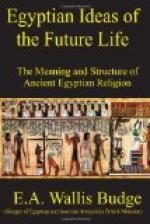The names of the beings who at one time or another were called “gods” in Egypt are so numerous that a mere list of them would fill scores of pages, and in a work of this kind would be out of place. The reader is, therefore, referred to Lanzone’s Mitologia Egizia, where a considerable number are enumerated and described.
CHAPTER IV.
THE JUDGMENT OF THE DEAD.
The belief that the deeds done in the body would be subjected to an analysis and scrutiny by the divine powers after the death of a man belongs to the earliest period of Egyptian civilization, and this belief remained substantially the same in all generations. Though we have no information as to the locality where the Last Judgment took place, or whether the Egyptian soul passed into the judgment-hall immediately after the death of the body, or after the mummification was ended and the body was deposited in the tomb, it is quite certain that the belief in the judgment was as deeply rooted in the Egyptians as the belief in immortality. There seems to have been no idea of a general judgment when all those who had lived in the world should receive their reward for the deeds done in the body; on the contrary, all the evidence available goes to show that each soul was dealt with individually, and was either permitted to pass into the kingdom of Osiris and of the blessed, or was destroyed straightway. Certain passages in the texts seem to suggest the idea of the existence of a place for departed spirits wherein the souls condemned in the judgment might dwell, but it must be remembered that it was the enemies of R[=a], the Sun-god, that inhabited this region; and it is impossible to imagine that the divine powers who presided over the judgment would permit the souls of the wicked to live after they had been condemned and to become enemies of those who were pure and blessed. On the other hand, if we attach any importance to the ideas of the Copts upon this subject, and consider that they represent ancient beliefs which they derived from the Egyptians traditionally, it must be admitted that the Egyptian underworld contained some region wherein the souls of the wicked were punished




